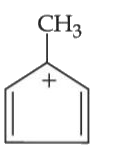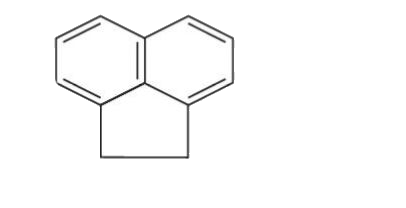Which one of the following compounds is aromatic in nature ?




To determine which of the given compounds is aromatic in nature, we need to apply the criteria for aromaticity. The criteria are:
1. The compound must be cyclic.
2. The compound must be planar.
3. The compound must have a continuous overlap of p-orbitals (conjugation).
4. The compound must follow Huckel's rule, which states that the number of π (pi) electrons must be equal to 4n+2, where n is a non-negative integer.
Now, let's analyze each option step by step:
Step 1: Analyze the first compound
- Count the π electrons: The first compound has 2 π bonds, which means it has 4 π electrons.
- Check for aromaticity: According to Huckel's rule, 4 π electrons correspond to n=1 in 4n+2 (which gives 6 π electrons). Since 4 is not equal to 4n+2, this compound is anti-aromatic.
Conclusion: The first compound is not aromatic.
Step 2: Analyze the second compound
- Count the π electrons: The second compound has 2 π bonds and a negative charge, which contributes 2 additional π electrons. Therefore, it has a total of 6 π electrons.
- Check for aromaticity: The compound is planar, and the π electrons are in conjugation. Since 6 π electrons satisfy Huckel's rule (n=1), this compound is aromatic.
Conclusion: The second compound is aromatic.
Step 3: Analyze the third compound
- Count the π electrons: The third compound has 2 π bonds and a positive charge, which indicates the loss of 2 electrons. Thus, it has 4 π electrons.
- Check for aromaticity: The compound is planar and has conjugated π bonds. However, with 4 π electrons, it does not satisfy Huckel's rule and is classified as anti-aromatic.
Conclusion: The third compound is not aromatic.
Step 4: Analyze the fourth compound
- Count the π electrons: The fourth compound consists of two benzene rings, which means it has 5 π bonds (each benzene has 6 π electrons). Therefore, it has a total of 10 π electrons.
- Check for aromaticity: The compound is planar, and the π electrons are in conjugation. Since 10 π electrons satisfy Huckel's rule (n=2), this compound is aromatic.
Conclusion: The fourth compound is aromatic.
Final Answer:
The compounds that are aromatic in nature are Option 2 and Option 4.
---
2. The compound must be planar.
3. The compound must have a continuous overlap of p-orbitals (conjugation).
4. The compound must follow Huckel's rule, which states that the number of π (pi) electrons must be equal to 4n+2, where n is a non-negative integer.
- Count the π electrons: The first compound has 2 π bonds, which means it has 4 π electrons.
- Check for aromaticity: According to Huckel's rule, 4 π electrons correspond to n=1 in 4n+2 (which gives 6 π electrons). Since 4 is not equal to 4n+2, this compound is anti-aromatic.
Conclusion: The first compound is not aromatic.
- Count the π electrons: The second compound has 2 π bonds and a negative charge, which contributes 2 additional π electrons. Therefore, it has a total of 6 π electrons.
- Check for aromaticity: The compound is planar, and the π electrons are in conjugation. Since 6 π electrons satisfy Huckel's rule (n=1), this compound is aromatic.
- Count the π electrons: The third compound has 2 π bonds and a positive charge, which indicates the loss of 2 electrons. Thus, it has 4 π electrons.
- Check for aromaticity: The compound is planar and has conjugated π bonds. However, with 4 π electrons, it does not satisfy Huckel's rule and is classified as anti-aromatic.
- Count the π electrons: The fourth compound consists of two benzene rings, which means it has 5 π bonds (each benzene has 6 π electrons). Therefore, it has a total of 10 π electrons.
- Check for aromaticity: The compound is planar, and the π electrons are in conjugation. Since 10 π electrons satisfy Huckel's rule (n=2), this compound is aromatic.
The compounds that are aromatic in nature are Option 2 and Option 4.
Topper's Solved these Questions
- BOOK - JEE MAINS PREVIOUS YEARCHAPTER - JEE MAINS 2021EXERCISE - Chemistry Section B20videos
JEE MAINS 2021
- BOOK - JEE MAINS PREVIOUS YEARCHAPTER - JEE MAINS 2021EXERCISE - Chemistry (Section A)80videos
JEE MAINS 2021
- BOOK - JEE MAINS PREVIOUS YEARCHAPTER - JEE MAINS 2021EXERCISE - CHEMISTRY (SECTION-B)40videos
JEE MAINS 2021
- BOOK - JEE MAINS PREVIOUS YEARCHAPTER - JEE MAINS 2020EXERCISE - CHEMSITRY25videos
JEE MAINS 2020
- BOOK - JEE MAINS PREVIOUS YEARCHAPTER - JEE MAINS 2022EXERCISE - CHEMISTRY (SECTION-B)10videos
JEE MAINS 2022
Similar Questions
Knowledge Check
- Question 1 - Select One
Which of the following compounds is aromatic in nature?
A B
B C
C D
D
- Question 2 - Select One
Which one of the following compounds is diamagnetic in nature?
A[CuCl4]2−B[Ni(CN)4]2−C[Fe(CN)6]3−D[NiCL4]2− - Question 3 - Select One
Which of the following compound is an Aromatic in nature ?
A B
B C
C D
D
Which of the following compounds is not aromatic ?
View SolutionWhich one of the following compounds is not aromatic ?
View SolutionWhich one of the following compounds is not aromatic?
View SolutionWhich of the following compounds is not aromatic ?
View SolutionWhich of the following compound is not aromatic ?
View Solution

